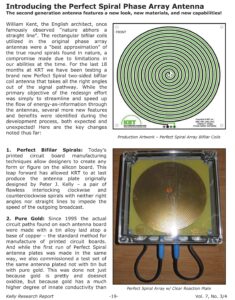Scalar Waves / Tesla waves.
Scalar waves, also known as Tesla waves, are a type of electromagnetic wave that differs from the more familiar Transverse Electromagnetic (EM) waves, such as radio waves, microwaves and visible light. Unlike conventional EM waves, scalar waves are believed to be non-Hertzian, meaning they do not travel through space in the same way as traditional electromagnetic waves.
Scalar waves are often described as standing waves, meaning they do not move through space but exist as stationary patterns of energy. These waves are characterized by their potential to interact with and influence matter at the quantum level, giving rise to their reputation for having unique properties.
The concept of scalar waves can be traced back to the pioneering work of the brilliant inventor and engineer, Nikola Tesla. Tesla, known for his groundbreaking contributions to the development of Alternating Current (AC) electricity and numerous other inventions, was intrigued by the idea of scalar waves. He believed that scalar waves held the key to a new understanding of energy and its potential applications. One of Tesla’s notable experiments involving scalar waves is the Colorado Springs experiments. In these experiments, he sought to transmit electromagnetic energy wirelessly over long distances. He claimed that scalar waves could be harnessed for wireless power transmission, potentially providing a limitless source of energy for the world. Unfortunately, his ambitious vision faced challenges in terms of funding and recognition and it remains largely unrealized to this day.
Scalar waves are often associated with several unique properties. Scalar waves are thought to exist beyond the limitations of Hertzian waves, which have a specific frequency and wavelength. Scalar waves are believed to have zero frequency, meaning they do not oscillate in the traditional sense. This property allows them to transcend the constraints of space and time. Scalar waves are often linked to the concept of non-locality in quantum physics. They are believed to act instantaneously at a distance, defying the speed of light and the limitations imposed by the theory of relativity. Some proponents of scalar wave technology claim that these waves can have healing properties. Devices that emit scalar waves, such as “scalar energy pendants” or “scalar wave generators,” are promoted as tools for promoting physical and emotional wellbeing. However, scientific evidence supporting these claims is often limited or inconclusive. Scalar waves are said to operate on the principles of resonance and harmonics. They are believed to interact with specific frequencies in the human body or other biological systems, potentially influencing cellular processes and promoting balance. The concept of scalar waves has not been without its share of controversies and skepticism within the scientific community. Many scientists and skeptics argue that the properties attributed to scalar waves often lack empirical evidence and rigorous scientific validation. Many claims associated with scalar waves are based on anecdotal evidence or pseudoscientific assertions.
Scalar waves are often said to defy well-established principles of physics, such as the conservation of energy and the theory of relativity. Skeptics argue that such claims should be thoroughly scrutinized and supported by rigorous experimental data. The field of scalar wave technology has attracted its fair share of commercial exploitation. Products promising miraculous health benefits or energy solutions are marketed with little scientific support, raising concerns about consumer protection and ethical practices. Some argue that the popularization of scalar waves as a concept has overshadowed Nikola Tesla’s legitimate contributions to science and engineering, potentially tarnishing his reputation. Despite the skepticism surrounding scalar waves, there are ongoing efforts to explore their potential applications and conduct scientific research in this field.
Scalar waves are conceived as longitudinal waves, as are sound waves. Unlike the transversal waves of electromagnetism, which move up and down perpendicularly to the direction of propagation, longitudinal waves vibrate in line with the direction of propagation. Transversal waves can be observed in water ripples: the ripples move up and down as the overall waves move outward, such that there are two actions; one moving up and down, and the other propagating in a specific direction outward.
Technically speaking, scalar waves have magnitude but no direction, since they are imagined to be the result of two electromagnetic waves that are 180 degrees out of phase with one another, which leads to both signals being canceled out. This results in a kind of ‘pressure wave’.
Mathematical physicist James Clerk Maxwell, in his original mathematical equations concerning electromagnetism, established the theoretical existence of scalar waves. After his death, however, later physicists assumed these equations were meaningless, since scalar waves had not been empirically observed and repeatedly verified among the scientific community at large.
Vibrational, or subtle energetic research, however, has helped advance our understanding of scalar waves. One important discovery states that there are many different types of scalar waves, not just those of the electromagnetic variety. For example, there are vital scalar waves (corresponding with the vital or “qi” body), emotional scalar waves, mental scalar waves, causal scalar waves, and so forth. In essence, as far as we are aware, all “subtle” energies are made up of various types of scalar waves.
Some general properties of scalar waves (of the beneficial kind) include:
- Travel faster than the speed of light.
- Seem to transcend space and time.
- Cause the molecular structure of water to become coherently reordered.
- Positively increase immune function in mammals.
- Are involved in the formation process in nature.
Not all scalar waves, or subtle energies, are beneficial to living systems. Electromagnetism of the 60 Hz AC variety, for example, emanates a secondary longitudinal/scalar wave that is typically detrimental to living systems.


